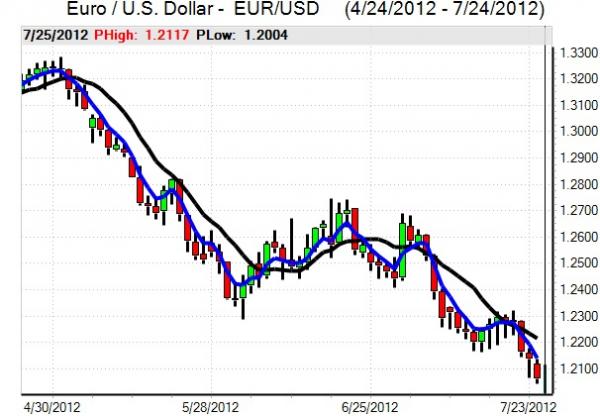EUR/USD
The Euro was unable to make significant headway during Tuesday and retreated to test fresh two-year lows around 1.2050 where there was rumoured to be strong interest in defending option positions.
The latest Euro-zone PMI data provided no significant relief for the currency as the manufacturing sector declined at a slightly faster rate during the month to a three-year low of 44.1. The impact was offset to some extent by a stabilisation in the composite index as the services sector edged higher.
Spain continued to be an extremely important market focus as underlying sentiment continued to deteriorate. Although there was a relatively satisfactory bill auction, underlying bond yields continued to rise with the benchmark 10-year yield moving above the 7.50% level. There were reports that Catalonia was looking to access the government’s support programme, although this denied by other officials. There were fears of an imminent loss of Spain’s investment-grade credit rating which would further damage market access and trigger additional capital outflows as well as further undermining the banking sector.
The IMF-led troika started their visit to Greece and the underlying tone from officials was generally negative with one EU official describing Greece as being pretty terrible, increasing speculation that Greece would effectively be pushed out of the Euro. There were also further concerns surrounding the Italian economy and the local bourse weakened to the lowest level since 1999.
There was a sharp decline in the latest US Richmond Fed index which reinforced fears surrounding a slowdown in the US economy and contributed to a general increase in risk aversion. The Euro was unable to gain much support in any environment, especially with rumours that the ECB would consider a negative deposit rate as it consolidated just above the 1.2050 level.

Source: VantagePoint Intermarket Analysis Software
Call now and you will be provided with FREE recent forecasts
that are up to 86% accurate* 800-732-5407
If you would rather have the recent forecasts sent to you, please go here
Yen
The dollar was unable to gain any traction against the yen during Tuesday with resistance above the 78.30 level, although it did find support on dips towards 78.10.
There was speculation of moves to intervene to sell the yen which dampened interest in buying the yen aggressively as officials started to increase rhetoric against yen gains. New Bank of Japan board member Kiuchi also stated that further measures to curb deflation may be required. There was still underlying yen support from a deterioration in global risk appetite.
The headline trade account was stronger than expected with a JPY62bn surplus as the export decline was slightly lower than expected while import demand was weak. The dollar consolidated just above the 78 level against the dollar in Asia on Wednesday.
Sterling
Sterling hit resistance just above 1.5550 against the US dollar on Tuesday and retreated to test support below 1.55. Moves were cushioned by renewed gains against the Euro as a Euro move to above 0.78 reversed quickly.
The latest mortgage lending data was significantly weaker than expected for June with BBA approvals of 26,300 from 29,600 previously which increased unease over bank lending trends and the outlook for consumer spending.
The GDP data to be released on Wednesday will have an important economic and political impact with pressure for a more aggressive fiscal policy if there is a further contraction in output for the quarter. There was still evidence of defensive inflows into Sterling as Euro-zone fears intensified.
Swiss franc
The dollar found support close to 0.99 against the franc on Tuesday and pushed to fresh 19-month highs around 0.9970. There was no break in the Euro pattern as it remained trapped close to the 1.2010 area with evidence of further aggressive National Bank intervention to keep the Euro afloat.
With confidence in the Spanish outlook continuing to deteriorate, there will be further speculation of an increase in capital inflows into Swiss assets. This will increase market speculation over capital controls to stem potential capital flight from the Euro-zone.

Source: VantagePoint Intermarket Analysis Software
Call now and you will be provided with FREE recent forecasts
that are up to 86% accurate* 800-732-5407
If you would rather have the recent forecasts sent to you, please go here
Australian dollar
The Australian dollar hit resistance close to the 1.03 level against the US dollar on Tuesday and, after proving resilient for much of the session, was subjected to renewed selling in New York as it dipped to lows near 1.0220. There was further downward pressure on equity markets and a general tone of risk aversion during the session with weaker than expected results from Apple undermining confidence.
The latest inflation data was slightly weaker than expected with a core and headline increase of 0.5% for the second quarter which helped push the currency below the 1.02 level before a recovery back to just above this level.



